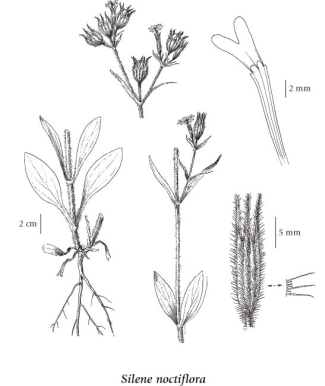Silene noctiflora L.
night-flowering catchfly (nightflowering silene; sticky cockle)
Caryophyllaceae (Pink family)
Introduction to Vascular Plants
night-flowering catchfly (nightflowering silene; sticky cockle)
Caryophyllaceae (Pink family)
Introduction to Vascular Plants
Species Information
General:
Annual herb from a taproot; stems erect, several, branched, hairy, becoming sticky-hairy above, 20-90 cm tall.
Leaves:
Basal leaves spoon-shaped, 5-12 cm long, short-stalked; stem leaves opposite, lanceolate to elliptic, 2-10 cm long, up to 4 cm wide, unstalked, hairy above and below; stipules lacking.
Flowers:
Inflorescence of 2-many flowers in a cluster, opening at night, fragrant; petals 5, yellowish beneath and rosy above, glabrous, stalklike at the bases, the blades 7-10 mm long, the stalks 12-25 mm long, 2-cleft less than 1/2 their length; sepals 5, greenish to pinkish, united, forming a woolly, glandular-hairy tube 12-25 mm long, 10-nerved.
Fruits:
Capsules egg-shaped, 1.5-2.5 cm long, 6-valved; seeds 0.8-1.2 mm long, brown, roughened.
Illustration

If more than one illustration is available for a species (e.g., separate illustrations were provided for two subspecies) then links to the separate images will be provided below. Note that individual subspecies or varietal illustrations are not always available.
Illustration Source: The Illustrated Flora of British Columbia
Ecology
Ecological Framework for Silene noctiflora
The table below shows the species-specific information calculated from
original data (BEC database) provided by the BC Ministry of Forests and Range.
(Updated August, 2013)
The table below shows the species-specific information calculated from
original data (BEC database) provided by the BC Ministry of Forests and Range.
(Updated August, 2013)
| Site Information |
Value / Class |
||
|
Avg |
Min |
Max |
|
| Elevation
(metres) |
1375 | 350 | 2330 |
| Slope
Gradient (%) |
35 | 0 | 85 |
|
Aspect (degrees) |
198 | 20 | 350 |
| Soil
Moisture Regime (SMR) [0 - very xeric; 4 - mesic; 8 - hydric] |
3 | 0 | 6 |
| Modal
Nutrient Regime
Class |
C | ||
| #
of field plots species was recorded in: |
23 | ||
| Modal
BEC Zone Class |
IDF | ||
|
All BEC Zones (# of stations/zone) species was recorded in |
BG(3), ESSF(9), IDF(9), MS(1), PP(1) | ||
|
Source:
Klinkenberg 2013
|
|||
Habitat and Range
Mesic to dry waste places and cultivated fields in the lowland, steppe and montane zones; common in S BC, rare on the Queen Charlotte Islands; introduced from Europe.Status Information
Synonyms
Synonyms and Alternate Names:
Melandrium noctiflorum (L.) Fr.
